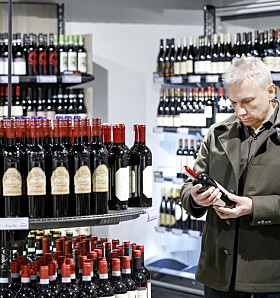
How much alcohol is too much? Countries give different advice
The answer you get depends on which country you live in. Research is just one of the considerations health authorities take into account when setting this limit, according to a substance use researcher.
When the Nordic dietary guidelines were launched last week, many were taken aback. Their message was that there is no safe level of alcohol consumption.
Unlike many other countries, Norway has not had any recommended limit for alcohol intake.
There is currently a significant difference in the recommended alcohol intake limits set by different countries.
The extremes in Europe are the Netherlands and Italy, according to Jørgen Bramness. He is a senior researcher at the Norwegian Institute of Public Health and a professor at UiT - the Arctic University of Norway.
The Netherlands, which has the lowest limit in Europe, has a limit of 10 grams of alcohol a day, which is less than one unit of alcohol.
Italy has the highest limit, allowing up to 40 grams per day, which is equivalent to about four units.
Not solely based on research
Research is just one of the considerations health authorities take into account when setting this limit. It also involves cultural factors, Bramness says.
“Some countries have chosen to set the limit high. These are countries that have traditions of high alcohol consumption. Others have chosen to set it lower,” he says.
While it has been common internationally to provide advice on how much people can drink before it affects their health, the Norwegian health authorities have not done so, Bramness says.
“We have no official threshold values for risky alcohol consumption or recommendations for weekly or daily alcohol consumption. The general advice from Norwegian health authorities has always been that there is a risk associated with drinking and that there is no safe limit," he explains.

Confusion
The website of the Norwegian Directorate of Health actually states that the current Norwegian advice is for women not to exceed 10 grams of alcohol per day, which is roughly equivalent to a small glass, while men should not exceed 20 grams.
This information is however incorrect, according to Linda Granlund, the divisional director for public health at the Norwegian Directorate of Health. She says they will address this issue.
The Norwegian Directorate of Health will also start the process of updating the Norwegian dietary guidelines based on the new Nordic guidelines.
Arbitrary limits
Jørgen Bramness believes it is sensible that Norway does not set a specific limit for recommended alcohol consumption.
If you look at the research, it does not provide any clear answers about whether it is dangerous to drink one or four glasses a day, he explains.
“Setting a limit becomes more or less arbitrary,” he says. “It can be too high for some and too low for others. If you do not set a limit, you can convey that there is a risk associated with drinking regardless, and this risk starts at zero.”
Not a message of total abstinence
The absence of a specific limit should not be interpreted as a message of total abstinence, according to the researcher.
“It's just about being aware that there may be risks associated with drinking alcohol. It’s similar to the risks of moving around in traffic,” he explains. “Every day carries risks. If you want to avoid any risk of being involved in a traffic accident, you have to stay away from traffic altogether. Most people are willing to take a certain risk. The same goes for advice on alcohol consumption.”
Bramness admits that conveying the concept of risk is very complicated for both health authorities and researchers
The most important health policy measures in Norway, however, are not related to these guidelines from health authorities, according to the researcher.
"It's about having a state monopoly on alcohol sales, high alcohol prices, a high minimum age limit, and other restrictions on alcohol sales. These factors are much more important for public health than what is stated in a recommendation," he says.
Canada has become strict
Norway and the Nordic countries are not alone in becoming more concerned about the harmful effects of alcohol.
Canada recently issued the strictest recommendations for alcohol consumption internationally.
In January, Canadian authorities released new national recommendations for the alcohol consumption for the Canadian population, advising not to drink more than two units per week.
The Canadian report also concluded that no amount of alcohol is good for health. Even a small amount of alcohol is harmful, according to an article in the Norwegian Journal of Nutrition (link in Norwegian).
Many Canadians have met these recommendations with scepticism and believe it is scaremongering by the authorities, the author of the journal article writes.
Strong alcohol industry
Bramness believes that many countries now have a goal to reduce the harms associated with alcohol consumption.
This is because research increasingly shows the health risks of alcohol use.
In early January, the World Health Organization (WHO) released a statement in the The Lancet stating that no amount of alcohol is safe for health.
Risks start from the first drop, WHO argues.
According to Bramness, the strong alcohol industry has had vested interest in creating a distinction between recreational use and risky use.
For the longest time, they have tried to convey that it is possible to drink alcohol without it being dangerous to health.
“It is therefore very gratifying that the authorities in many countries distance themselves from this standpoint,” he says.
———
Translated by Alette Bjordal Gjellesvik.
Read the Norwegian version of this article on forskning.no





































